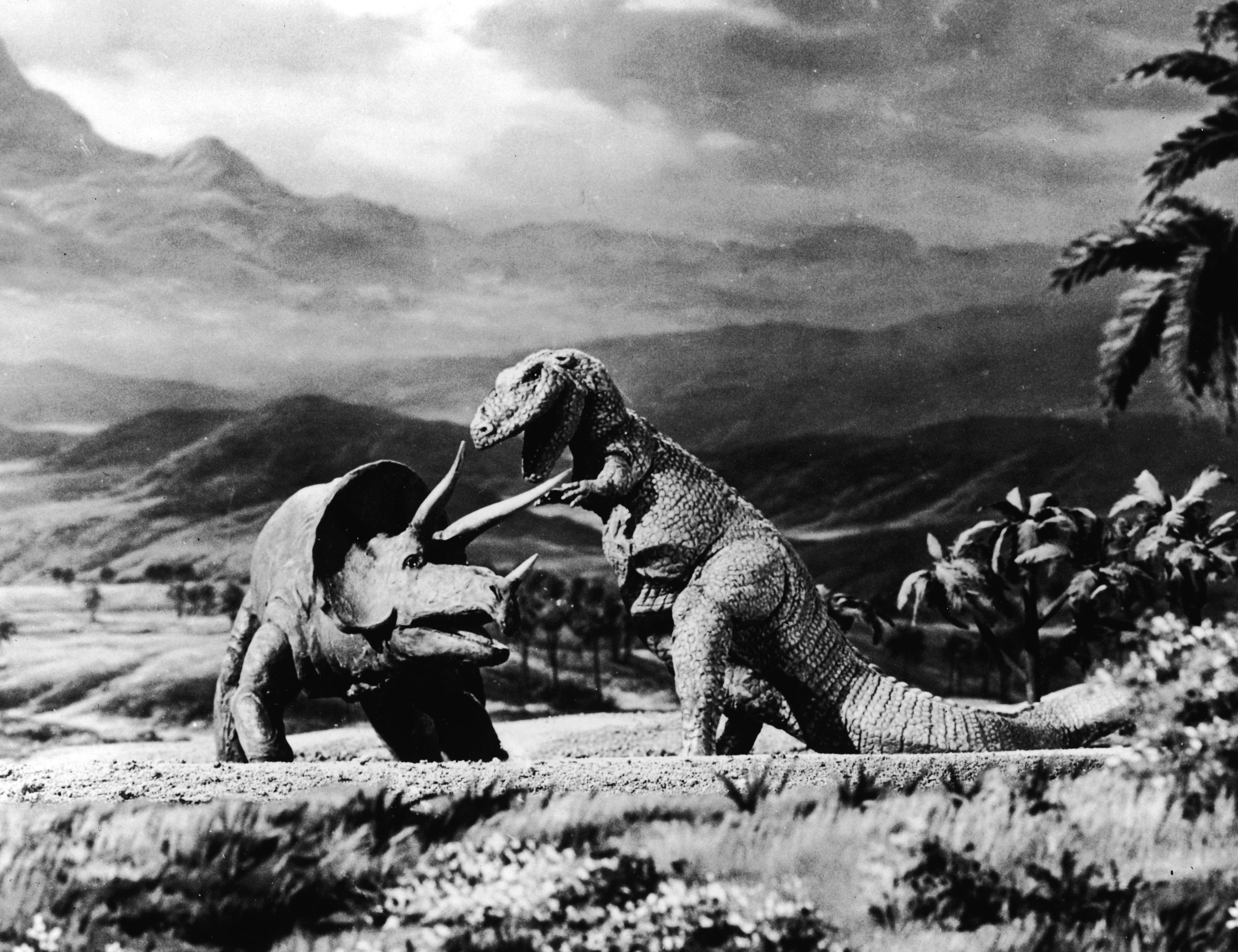Create a free profile to get unlimited access to exclusive videos, sweepstakes, and more!
T. Rex and Triceratops frozen in combat may finally be telling the truth about a 67-million-year-old cold case

This might as well be Mortal Kombat: Cretaceous Edition.
There have been controversies involving dinosaurs before, including a skeleton listed on eBay that caused an uproar among paleontologists, but none so infamous as the “Dueling Dinosaurs.” The famous fossilized T. Rex and Triceratops that died in the throes of combat never knew so much turmoil would happen over them 67 million years later. The huge hunks of stone they are preserved in contain all of their bones as well as body outlines and skin impressions — possibly even soft tissues and stomach contents. No wonder they have been through a failed auction and an entire lawsuit. But now the dinosaurs will finally get a chance to testify.
A team of paleontologists from the North Carolina Museum of Natural Sciences will soon open DinoLab, where they will CT scan and further study the specimens to look for soft tissues, proteins, and evidence of wounds or diseases. This could be the only known large-scale scene of dinosaurs going at each other. Most dinosaur behavior can only be theorized, but these two actually provide hard evidence. They have survived the ravages of time so well that the only known skin impressions of the Triceratops' bony frill and the T. Rex’s feet remain. This is about the closest to the next-gen lab in Jurassic World we’ll ever get. Visitors to this lab will actually be able to see the scientists in action, but what will the dinosaurs have to say?
"We’ll use CT scanning and 3D printing to be able to study and reproduce bones we cannot see with the naked eye," paleontologist Lindsay Zanno, who is leading the DinoLab project at the Raleigh museum, told SYFY WIRE. "We will also use various imaging and molecular techniques to identify and study soft tissue preservation, histology to identify the age and growth trajectory of the individuals, biomechanical approaches to better understand how the injuries we observe might have occurred and how the animals moved in life, radiometric dating to age the surrounding strata, and of course, comparative anatomy and systematics to generate new information on the biodiversity and family tree of tyrannosaurs and ceratopsians."
Because of all the battles these already fighting dinosaurs have been through, they ended up being shut away from scientific research. The trouble started when commercial fossil hunter Clayton Phipps and his team unearthed them on a Montana farm in 2006. When Phipps tried to sell the fossil to museums and institutions, they all declined, so he tried to auction it off instead. The disappointing high bid of $5.5 million for a fossil that had been appraised for nearly twice that found him stashing the fossils in storage. Dinosaur fossil auctions are already an ethical issue because of irreplaceable relics going to private owners who may never give them a chance to be studied.
"Museums are not the driving force behind skyrocketing prices," she said. "Our museum took an ethical stance by being unwilling to participate in the auction of these fossils, which is a direct action that drives up the cost of specimens on the private market. Instead we worked to develop a relationship with the landowners and the discovery team to ensure the scientific integrity of the specimens and secure them in a free public institution, where they can be enjoyed by all."
Ethics are also called into question when museums need to pay exorbitant amounts of money to private owners so they can get their hands on them. Zanno contacted Phipps in 2016. The North Carolina Museum of Natural Sciences wanted to buy the fossil, but it was entangled in a legal clash about who really owned it and had the right to sell it.
"The acquisition of the Dueling Dinosaurs is directly enabling us to fund our research and educational mission; because of the acquisition, we’ve so far raised a near equal amount of funds that are going directly to support research and so much more," Zanno said.
T. Rex were not fast on their feet, at least as adults. They were lumbering monsters that had to find the right moment to strike. Thought to be ambush predators, they probably snatched up easy meals by stalking prey at a watering hole or some other place herbivores would be hanging out. Apparently, not all victims went down that easily. Even something with jaws of steel and dagger teeth could have had a hard time getting a bite when the menu item has giant horns and a bony shield (the “frill”) on its head. That didn’t always stop predators, since there has been evidence of some nasty T. Rex bite marks on a Triceratops frill.
Of the dueling dinosaurs, who defeated who? Maybe neither. They might have been swallowed by a mudslide before one could finish off the other. Only Zanno and her DinoLab scientists will be able to find that out.
"We do not yet have any idea if these two individual dinosaurs were in fact interacting at all," Zanno said. "We have a lot of research to do. Of all the scenarios we can put on the table to teset, one in which they were directly responsible for each other's deaths seems the most unlikely. To date most of the interest has been in how these animals died. I’m far more interested in what we can learn about their lives."


























